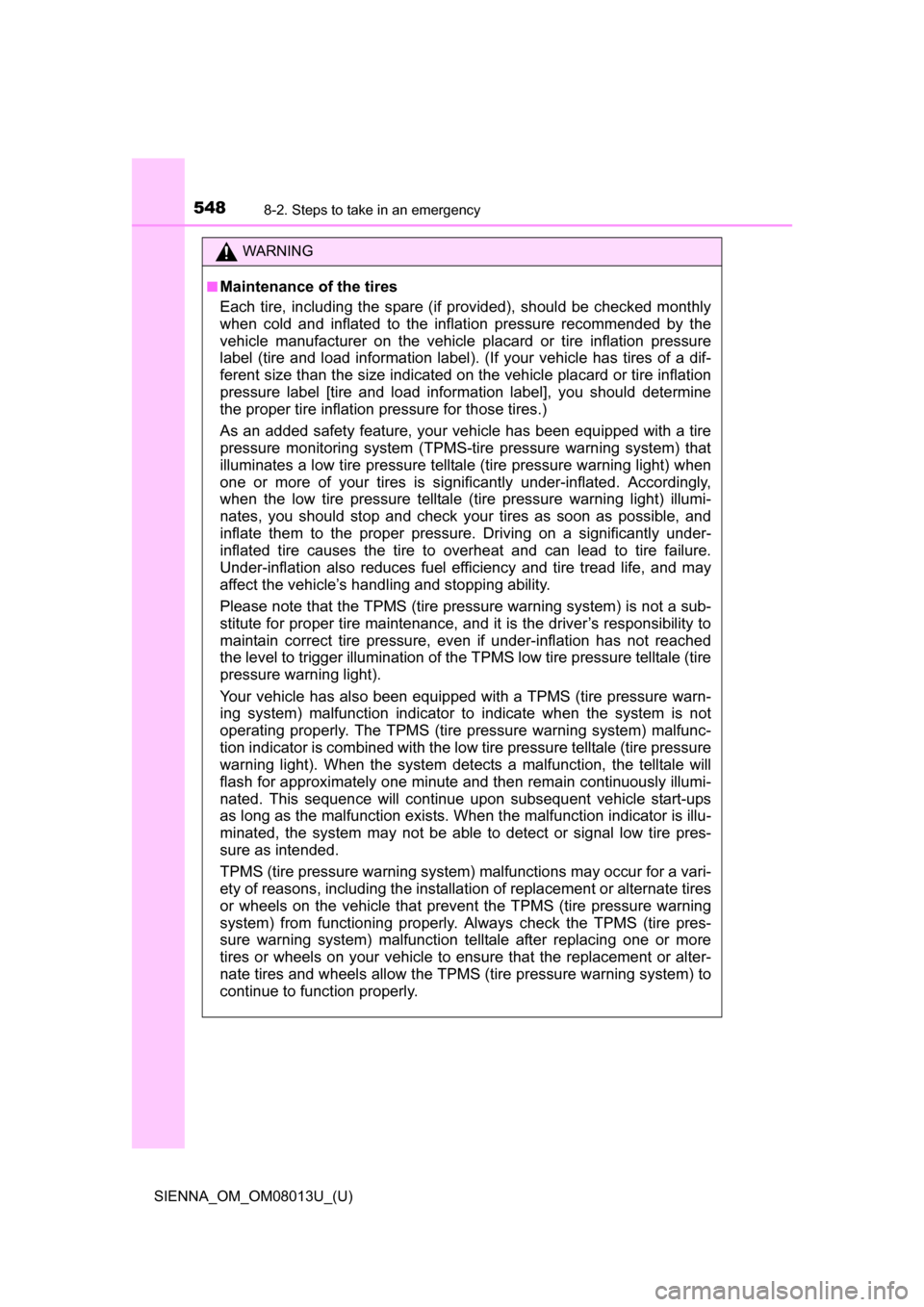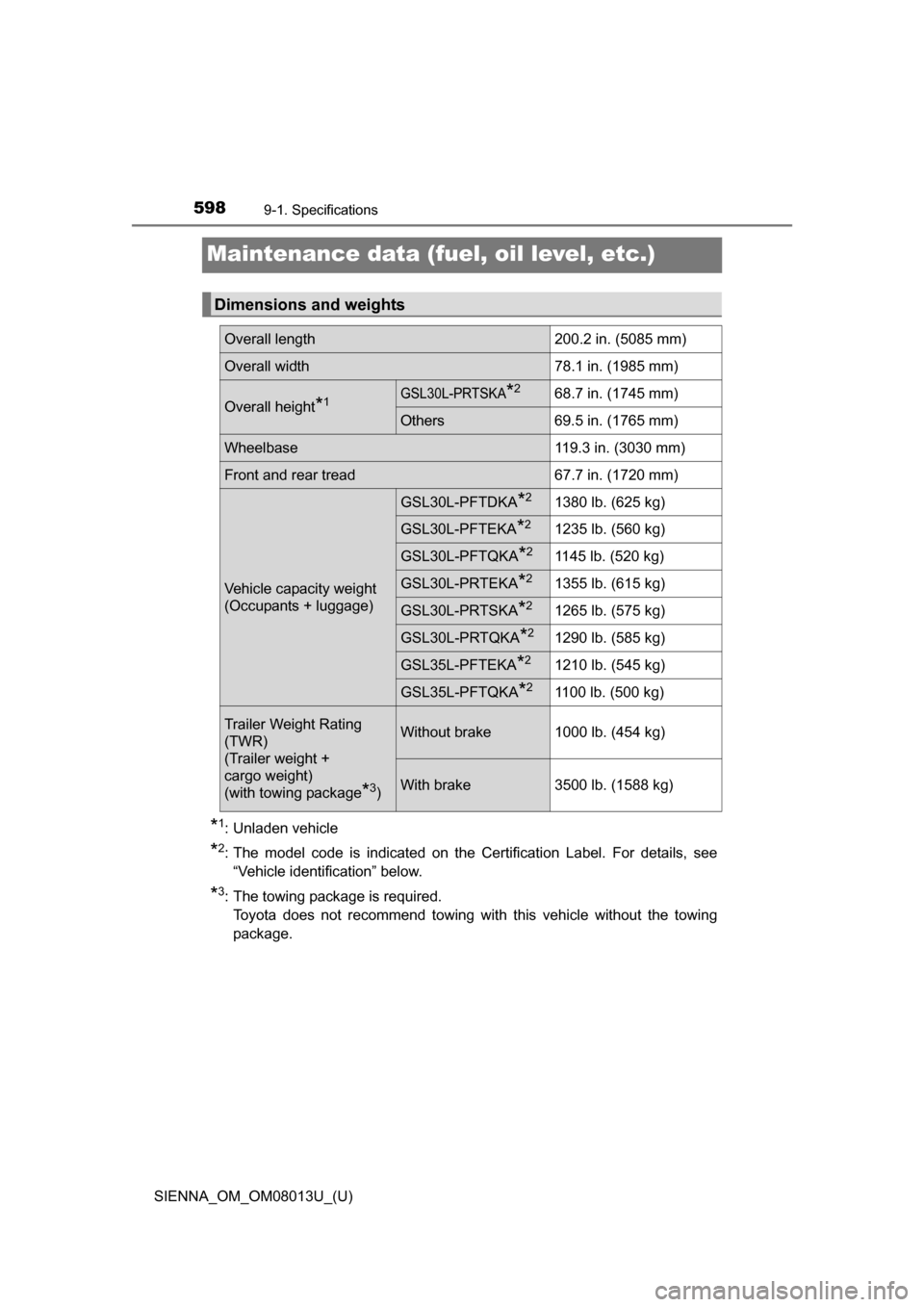Page 528 of 668
528
SIENNA_OM_OM08013U_(U)
7-3. Do-it-yourself maintenance
■Discharge headlights (if equipped)
If voltage to the discharge bulbs is insufficient, the bulbs may not come on, or
may go out temporarily. The discharge bulbs will come on when normal
power is restored.
■ LED lights
The daytime running lights (LED type), parking lights (LED type), stop/tail
(LED type), side turn signal light, r ear side marker lights and high mounted
stoplight consists of a number of LEDs. If any of the LEDs burn out, take your
vehicle to your Toyota dealer to have the light replaced.
■ Condensation build-up on the inside of the lens
Temporary condensation build-up on the inside of the headlight lens does not
indicate a malfunction. Contact your Toyota dealer for more information in the
following situations:
●Large drops of water have built up on the inside of the lens.
● Water has built up inside the headlight.
■ When replacing light bulbs
P. 512
Page 529 of 668

SIENNA_OM_OM08013U_(U)
5297-3. Do-it-yourself maintenance
7
Maintenance and care
WARNING
■Replacing light bulbs
●Turn off the lights. Do not attempt to replace the bulb immediately after
turning off the lights.
The bulbs become very hot and may cause burns.
● Do not touch the glass portion of the light bulb with bare hands. When it is
unavoidable to hold the glass portion, use and hold with a clean dry cloth
to avoid getting moisture and oils on the bulb. Also, if the bulb is scratched
or dropped, it may blow out or crack.
● Fully install light bulbs and any parts used to secure them. Failure to do so
may result in heat damage, fire, or water entering the headlight unit. This
may damage the headlights or cause condensation to build up on the lens.
● Do not attempt to repair or disassemble the bulb, socket, electrical wiring,
or sub components. This may cause serious injury due to electric shock.
●Vehicles with discharge headlights:
While the low beam headlights are
turned on, and for a short time after they
have been turned off, metal compo-
nents at the rear of the headlight
assembly will be extremely hot. To pre-
vent burns, do not touch these metal
components until you are certain they
have cooled down.
Metal components
Page 530 of 668

530
SIENNA_OM_OM08013U_(U)
7-3. Do-it-yourself maintenance
WARNING
■Discharge headlights (if equipped)
●Contact your Toyota dealer before replacing the discharge headlights
(including light bulbs).
● Do not touch the discharge headlight’s high voltage socket when the head-
lights are turned on.
An extremely high voltage of 30000 V will be discharged and could result
in serious injury or death by electric shock.
● Do not attempt to take apart or repair the low beam headlight bulbs, con-
nectors, power supply circuits, or related components.
Doing so could result in electric shock and death or serious injury.
■ When replacing the rear turn signal lights or stop/tail lights
Inspect the gasket for any damage (rip, tear, hole, etc.). If there is any dam-
age, please contact your Toyota dealer and have the gasket replaced.
Improper installation of the gasket may result in water entering the rear light
unit.
■ To prevent damage or fire
●Make sure bulbs are fully seated and locked.
● Check the wattage of the bulb before installing to prevent heat damage.
NOTICE
■When installing the back door trim
To prevent damage, be careful not to pinch any of the wire harnesses or
connectors with the back door trim.
Page 548 of 668

5488-2. Steps to take in an emergency
SIENNA_OM_OM08013U_(U)
WARNING
■Maintenance of the tires
Each tire, including the spare (if provided), should be checked monthly
when cold and inflated to the inflation pressure recommended by the
vehicle manufacturer on the vehicle placard or tire inflation pressure
label (tire and load information label). (If your vehicle has tires of a dif-
ferent size than the size indicated on the vehicle placard or tire inflation
pressure label [tire and load information label], you should determine
the proper tire inflation pressure for those tires.)
As an added safety feature, your vehicle has been equipped with a tire
pressure monitoring system (TPMS-ti re pressure warning system) that
illuminates a low tire pre ssure telltale (tire pressure warning light) when
one or more of your tires is significantly under-inflated. Accordingly,
when the low tire pressure telltale (tire pressure warning light) illumi-
nates, you should stop and check your tires as soon as possible, and
inflate them to the proper pressure. Driving on a significantly under-
inflated tire causes the tire to overheat and can lead to tire failure.
Under-inflation also reduces fuel effi ciency and tire tread life, and may
affect the vehicle’s hand ling and stopping ability.
Please note that the TPMS (tire pres sure warning system) is not a sub-
stitute for proper ti re maintenance, and it is the driver’s responsibility to
maintain correct tire pressure, even if under-inflation has not reached
the level to trigger illumina tion of the TPMS low tire pressure telltale (tire
pressure warning light).
Your vehicle has also been equipped with a TPMS (tire pressure warn-
ing system) malfunction indicator to indicate when the system is not
operating properly. The TPMS (tire pressure warning system) malfunc-
tion indicator is combined with the lo w tire pressure telltale (tire pressure
warning light). When the system dete cts a malfunction, the telltale will
flash for approximately one minute and then remain continuously illumi-
nated. This sequence will continue up on subsequent vehicle start-ups
as long as the malfunction exists. When the malfunction indicator is illu-
minated, the system may not be able to detect or signal low tire pres-
sure as intended.
TPMS (tire pressure warning system) malfunctions may occur for a vari-
ety of reasons, including the installati on of replacement or alternate tires
or wheels on the vehicle that prevent the TPMS (tire pressure warning
system) from functioning properly. Always check the TPMS (tire pres-
sure warning system) malfunction te lltale after replacing one or more
tires or wheels on your vehicle to ensure that the replacement or alter-
nate tires and wheels allow the TPMS (tire pressure warning system) to
continue to function properly.
Page 559 of 668
5598-2. Steps to take in an emergency
SIENNA_OM_OM08013U_(U)
8
When trouble arises
Indicates that the accelerator and brake pedal
are being depressed simultaneously
Release the accelerator or brake pedal.
Indicates that the washer fluid level is low
Add washer fluid.
Indicates that remaining fuel is approximately
3.0 gal. (11.4 L, 2.5 Imp.gal.) or less
Refuel the vehicle.
(U.S.A. only)
Indicates that all maintenance according to the
driven distance on the maintenance schedule
*
should be performed soon.
Comes on approximately 4500 miles (7200 km)
after the message has been reset.
If necessary, perform maintenance.
Warning messageDetails/Actions
(Flashes)
Page 560 of 668
5608-2. Steps to take in an emergency
SIENNA_OM_OM08013U_(U)
*: Refer to the separate “Scheduled Maintenance Guide” or “Owner’s ManualSupplement” for the maintenance interval applicable to your vehicle.
(U.S.A. only)
Indicates that all maintenance is required to cor-
respond to the driven distance on the mainte-
nance schedule
*.
Comes on approximately 5000 miles (8000 km)
after the message has been reset. (The indicator
will not work properly unless the message has
been reset.)
Perform the necessary maintenance.
Please reset the message after the mainte-
nance is performed ( P. 471)
(If equipped)
Indicates that the PCS (Pre-collision system) is
not currently functional because the grille cover
or the sensor is dirty
Check the grille cover and the sensor and
clean them if they are dirty.
Warning messageDetails/Actions
Page 597 of 668
597
SIENNA_OM_OM08013U_(U)
9Vehicle specifications
9-1. SpecificationsMaintenance data (fuel, oil level, etc.) .......... 598
Fuel information ................ 607
Tire information ................. 610
9-2. Customization Customizable features ...... 621
9-3. Initialization Items to initialize ............... 632
Page 598 of 668

598
SIENNA_OM_OM08013U_(U)
9-1. Specifications
Maintenance data (fuel, oil level, etc.)
*1: Unladen vehicle
*2: The model code is indicated on the Certification Label. For details, see“Vehicle identification” below.
*3: The towing package is required.Toyota does not recommend towing with this vehicle without the towing
package.
Dimensions and weights
Overall length 200.2 in. (5085 mm)
Overall width 78.1 in. (1985 mm)
Overall height*1GSL30L-PRTSKA*268.7 in. (1745 mm)
Others69.5 in. (1765 mm)
Wheelbase 119.3 in. (3030 mm)
Front and rear tread 67.7 in. (1720 mm)
Vehicle capacity weight
(Occupants + luggage)
GSL30L-PFTDKA*21380 lb. (625 kg)
GSL30L-PFTEKA*21235 lb. (560 kg)
GSL30L-PFTQKA*21145 lb. (520 kg)
GSL30L-PRTEKA*21355 lb. (615 kg)
GSL30L-PRTSKA*21265 lb. (575 kg)
GSL30L-PRTQKA*21290 lb. (585 kg)
GSL35L-PFTEKA*21210 lb. (545 kg)
GSL35L-PFTQKA*21100 lb. (500 kg)
Trailer Weight Rating
(TWR)
(Trailer weight +
cargo weight)
(with towing package
*3)
Without brake 1000 lb. (454 kg)
With brake3500 lb. (1588 kg)